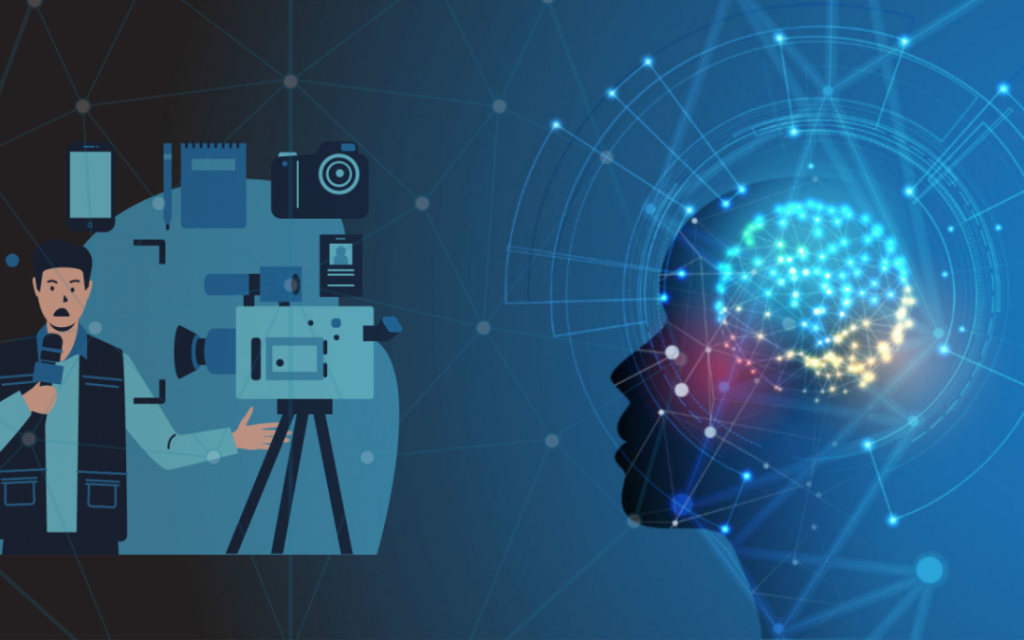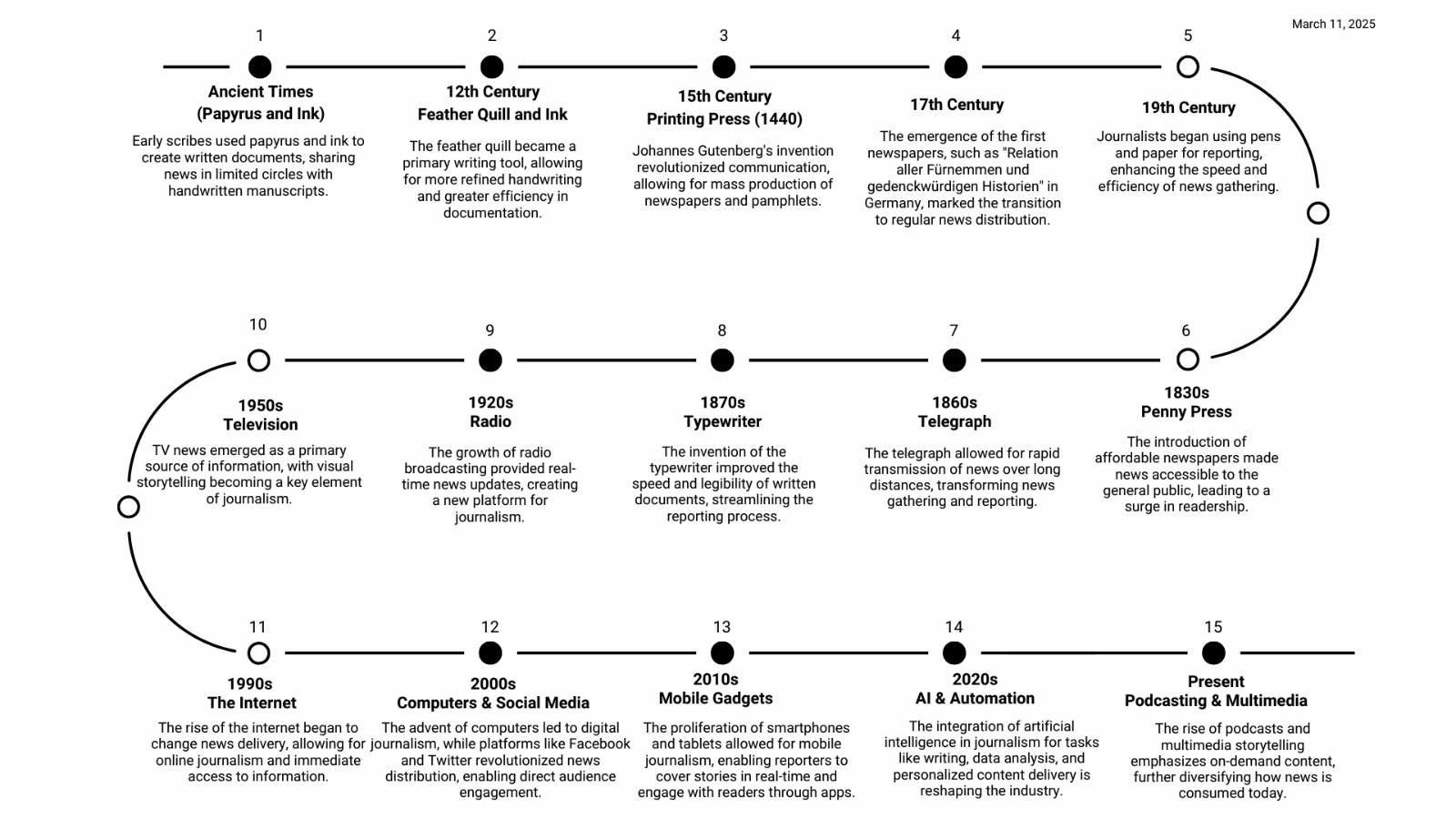The debate over artificial intelligence (AI) in journalism has reached a fever pitch, with detractors arguing that it fosters sloth and stifles creativity. I recently attended a webinar where these sentiments echoed loudly – some contributors painted AI as a crutch that dulls the sharp edge of journalistic ingenuity. To them, AI is a shortcut, a lazy journalist’s cheat code. I disagree. Having wielded AI in my own reporting, I’ve found it to be a catalyst for sharper focus, bolder creativity, and continuous learning. Far from dragging journalism into a creative abyss, AI is propelling it into a dynamic future. Those who cling to the idea that AI harms the craft might just be stuck in a romanticized past, unable to adapt to the evolution that has defined journalism for centuries.
Let’s rewind. Journalism has never been static. The quill and parchment gave way to the typewriter’s clackety rhythm, which in turn bowed to the hum of computers. Each leap forward sparked its own chorus of sceptics. When typewriters emerged, purists mourned the lost art of calligraphy, claiming it dulled the writer’s soul – a resistance documented in historical critiques of technological shifts (Baron, 2009[1]). When computers replaced typewriters, critics decried the death of tactile storytelling, fearing a loss of craft (Pavlik, 2023). Yet, these tools didn’t diminish journalism – they amplified it. Computers didn’t make reporters lazy; they freed them from mechanical drudgery to focus on narrative depth and investigative rigor. AI is simply the next chapter in this saga of progress, not a harbinger of decline.
The Evolution of the News-making Industry
After hearing a webinar participant insist that AI makes journalists lazy and erodes creativity, I decided to dig deeper into how the news-making industry has evolved. The journey from handwritten manuscripts to digital platforms reveals a field perpetually shaped by technology – each tool met with scepticism, yet ultimately embraced. Let’s take a look at the following historical timeline in the news-making industry.
AI as a Modern Ally
The charge that AI makes journalists slothful rests on a shaky premise: that it does the work for us. In reality, AI is a collaborator, not a replacement. It doesn’t write my stories – it sharpens my lens. When I feed it a rough draft, it suggests tighter phrasing or flags inconsistencies I might’ve missed in the haze of a deadline. When I task it with summarizing dense reports – say, a 200-page government study – it delivers a concise digest, saving hours of sifting. This isn’t laziness; it’s efficiency. The time I save isn’t spent idling but probing deeper angles, chasing leads, or crafting prose with a human touch no algorithm can replicate.
Creativity, too, thrives under AI’s influence. Critics argue it churns out formulaic content, flattening the art of storytelling. But this ignores how AI can spark inspiration. I’ve used it to brainstorm angles on a stale beat – say, urban housing crises – where it might suggest a lens like “micro-communities as a solution,” pushing me to explore ideas I hadn’t considered. A 2021 study on AI-augmented creativity found that tools like these can enhance divergent thinking when guided by human intent (Amabile & Pratt, 2021). It’s not about handing over the creative reins; it’s about lighting a fire under my own imagination. The real creativity lies in how I wield the tool, not in rejecting it outright. Those who see AI as a creativity-killer might lack the ingenuity to bend it to their will.
Moreover, AI demands journalists’ level up. Commanding it effectively requires precision – vague prompts yield vague results. I’ve learned to refine my questions, articulate my goals, and anticipate its limits. This isn’t passive reliance; it’s active engagement. It’s pushed me to read more widely, to understand data better, to master the craft of directing a system that’s only as good as the human steering it. Far from fostering sloth, AI has made me more alert, proactive, and intellectually nimble.
AI and Human Collaboration
Let’s address the elephant in the room: accuracy. Some AI tools, like early versions of ChatGPT, have been known to conjure fictitious sources – a valid concern in a field where credibility is currency (Pavlik, 2023). But this isn’t an indictment of AI itself; it’s a call for vigilance. I cross-check every AI-generated claim against primary sources, a habit honed by years of reporting. The Associated Press, for instance, has used AI to automate earnings reports since 2014, freeing journalists for investigative work while maintaining rigorous oversight (Associated Press, 2015). The tool didn’t erode standards – it elevated output. The onus is on us, not AI, to uphold journalistic integrity.
Data backs this up. A 2023 study by the Reuters Institute for the Study of Journalism found that 70% of newsrooms using AI reported increased productivity without compromising quality, with many journalists noting it enhanced their ability to tackle complex stories (Newman et al., 2023). This isn’t sloth – it’s empowerment. AI handles the grunt work – transcribing interviews, analysing datasets – leaving reporters to do what humans do best: connect, interpret, and narrate.
Journalism’s Resiliency
The naysayers might romanticize a pre-AI era, but journalism has always been about adapting to the tools of the time. Today’s typewriter loyalists would’ve been yesterday’s parchment purists. The craft evolves not by resisting change but by mastering it. AI isn’t a threat – it’s a challenge to rise above mediocrity. Those who claim it dulls creativity or breeds laziness might not be creative or diligent enough to harness it. I’ve seen the opposite: AI has made me a better journalist, not a lesser one.
So, to the webinar sceptics and beyond: stop clutching pearls and start embracing possibilities. AI isn’t here to replace us – it’s here to refine us. The future of journalism isn’t in rejecting tools but in wielding them with skill and vision. The lazy ones aren’t those using AI – they’re the ones too stubborn to evolve.
Structural Primer
Before I close this short expose, I would like to offer a practical guide for journalists to leverage AI as a tool for progressive learning and enhanced reporting. By integrating AI this way, journalists don’t just keep pace – they set it. It’s a tool for growth, not a shortcut to stagnation. Here are the basics I have learnt, which I hope you will find helpful:
- Define Clear Objectives: Start with a specific goal: summarizing a report, generating story ideas, or refining a draft. Vague inputs lead to vague outputs. Example: “Summarize this 50-page climate study in 200 words, focusing on policy impacts.
- Iterate and Refine: Treat AI as an iterative partner. If the first response isn’t perfect, tweak your prompt. Example: “Rewrite this piece to be more conversational” becomes “Make this piece punchy and relatable for a Gen Z audience.”
- Use AI for Research, Not Gospel: Task AI with finding background info or trends (e.g., “What are recent X posts on housing policy?”), then verify findings yourself. It’s a starting point, not a finish line.
- Boost Creativity with Prompts: Ask AI to suggest angles or metaphors. Example: “Give me five unique angles on renewable energy adoption.” Build on its ideas with your own flair.
- Automate the Mundane: Use AI for transcription, data analysis, or first drafts of routine stories (e.g., sports scores). This frees time for investigative or narrative work.
- Learn Continuously: Experiment with AI’s limits – test new commands, explore its reasoning. Each interaction sharpens your ability to direct it, enhancing your skill set, and last but not least – and perhaps the most important,
- Fact-Check Relentlessly: AI can hallucinate sources (Pavlik, 2023). Always trace claims to primary documents or reputable outlets. Tools like Google Scholar searches can confirm credibility. For this op-ed, I verified the Reuters study via their 2023 Digital News Report and the AP’s AI use via their 2015 announcement.
[1] Baron, N. S. (2009). Always on: Language in an online and mobile world. Oxford University Press.



As a storyteller, I agree with the author. AI has not only improved efficiency and sharpened creativity, but it has also opened the door to infinite possibilities for creative minds while reducing costs—unlike the pre-AI days, when a whole team was needed to achieve what can now be done with ease. It has also made the creative space more inclusive, giving brilliant dyslexic minds—who were once marginalised—a well-deserved seat at the table.
Well-written and humorous, with plenty of food for thought.